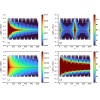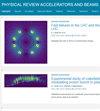应用于大型强子对撞机光束测量的非稳态信号谐波分析
IF 1.8
3区 物理与天体物理
Q3 PHYSICS, NUCLEAR
Physical Review Accelerators and Beams
Pub Date : 2024-09-16
DOI:10.1103/physrevaccelbeams.27.094001
引用次数: 0
摘要
谐波分析提供了强大的工具,可以从数字模拟或环形加速器和存储环中的光束测量所产生的逐行数据中准确确定调谐。自 20 世纪 90 年代以来开发的方法适用于静态信号,即特性不随时间变化且由静态信号表示的时间序列。然而,加速器物理学是一个丰富的时间序列来源,其中信号振幅随时间变化。此外,信号振幅变化的特性往往包含所考虑现象的重要信息。本文提出了一种适用于确定非稳态信号调谐的新方法,该方法基于希尔伯特变换的使用。本文详细评估了所提方法的准确性,并介绍和讨论了在欧洲核子研究中心大型强子对撞机收集的光束数据分析中的应用。本文章由计算机程序翻译,如有差异,请以英文原文为准。

Harmonic analysis of nonstationary signals with application to LHC beam measurements
Harmonic analysis has provided powerful tools to accurately determine the tune from turn-by-turn data originating from numerical simulations or beam measurements in circular accelerators and storage rings. Methods that have been developed since the 1990s are suitable for stationary signals, i.e., time series whose properties do not vary with time and are represented by stationary signals. However, it is common experience that accelerator physics is a rich source of time series in which the signal amplitude varies over time. Furthermore, the properties of the amplitude variation of the signal often contain essential information about the phenomena under consideration. In this paper, a novel approach is presented, suitable for determining the tune of a nonstationary signal, which is based on the use of the Hilbert transform. The accuracy of the proposed methods is assessed in detail, and an application to the analysis of beam data collected at the CERN Large Hadron Collider is presented and discussed in detail.
求助全文
通过发布文献求助,成功后即可免费获取论文全文。
去求助
来源期刊

Physical Review Accelerators and Beams
Physics and Astronomy-Surfaces and Interfaces
CiteScore
3.90
自引率
23.50%
发文量
158
审稿时长
23 weeks
期刊介绍:
Physical Review Special Topics - Accelerators and Beams (PRST-AB) is a peer-reviewed, purely electronic journal, distributed without charge to readers and funded by sponsors from national and international laboratories and other partners. The articles are published by the American Physical Society under the terms of the Creative Commons Attribution 3.0 License.
It covers the full range of accelerator science and technology; subsystem and component technologies; beam dynamics; accelerator applications; and design, operation, and improvement of accelerators used in science and industry. This includes accelerators for high-energy and nuclear physics, synchrotron-radiation production, spallation neutron sources, medical therapy, and intense-beam applications.
 求助内容:
求助内容: 应助结果提醒方式:
应助结果提醒方式:


